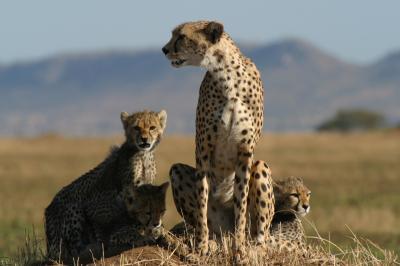While promiscuity in the animal kingdom is generally a male thing, researchers for the Wildlife Conservation Society and the Zoological Society of London (ZSL) have found that, in cheetah society, it’s the female with the wandering eye, as reported in a paper in the latest issue of Proceedings of the Royal Society B.
According to the study, researchers found that about 43 percent of cheetah litters with more than one cub were fathered by more than one male, revealing a mating system that deviates from those used by other carnivores, most of which consist of single or sibling males monopolizing many females. A new cheetah study by the Wildlife Conservation Society and the Zoological Society of London has found that many cheetah litters have more than one father. Credit: Tanzania Cheetah Conservation Program
A new cheetah study by the Wildlife Conservation Society and the Zoological Society of London has found that many cheetah litters have more than one father. Credit: Tanzania Cheetah Conservation Program
“It seems that female cheetahs are highly promiscuous with no detectable mate fidelity between breeding seasons,” said Dr. Sarah Durant, a researcher with the Wildlife Conservation Society/Tanzania Cheetah Conservation Program and project leader. “In fact, we now know many of the fathers exist outside the park and study area. This is a finding which gives us a critical insight into cheetah ecology and one that merits inclusion into future conservation efforts for the species.”
The nine-year study, which was conducted in the Serengeti National Park of Tanzania, focused on determining the paternity of cheetahs through the use of fecal samples that were then subjected to genetic testing. By comparing individual genetic micro-satellites from 171 samples, researchers not only were able to determine if more than one father contributed to a litter, but also which of the known male cheetahs in the study area had sired cubs. Surprisingly, few known males had, with only 21.3 percent being assigned paternity, although not all males in the study area had been sampled. At least some of these missing fathers undoubtedly resided outside the study area.
The findings corroborate established studies on ranging patterns of female and male cheetahs. Female cheetahs occupy a home range averaging some 833 square kilometers in size, whereas a male’s territory averages 37 square kilometers. In many carnivore species, it’s the males that have larger ranges that encompass several female ranges.
“The picture that emerges is that of wide-ranging females mating with a number of males, which could be an advantage in terms of helping to maintain genetic diversity,” said ZSL’s Dada Gottelli, the study’s lead author.
Findings from the study are significant for conservation efforts for the species, which is threatened by a number of human-related causes. Further, cheetahs have always existed in low densities, due to competition from larger predators such as the lion and hyena. “Our study shows that more fathers are contributing to the next generation than we thought,” added Durant. “This is good news for cheetahs, and a reminder that future conservation strategies need to encompass large landscapes if females are to continue to have access to many males.”
Source: Wildlife Conservation Society